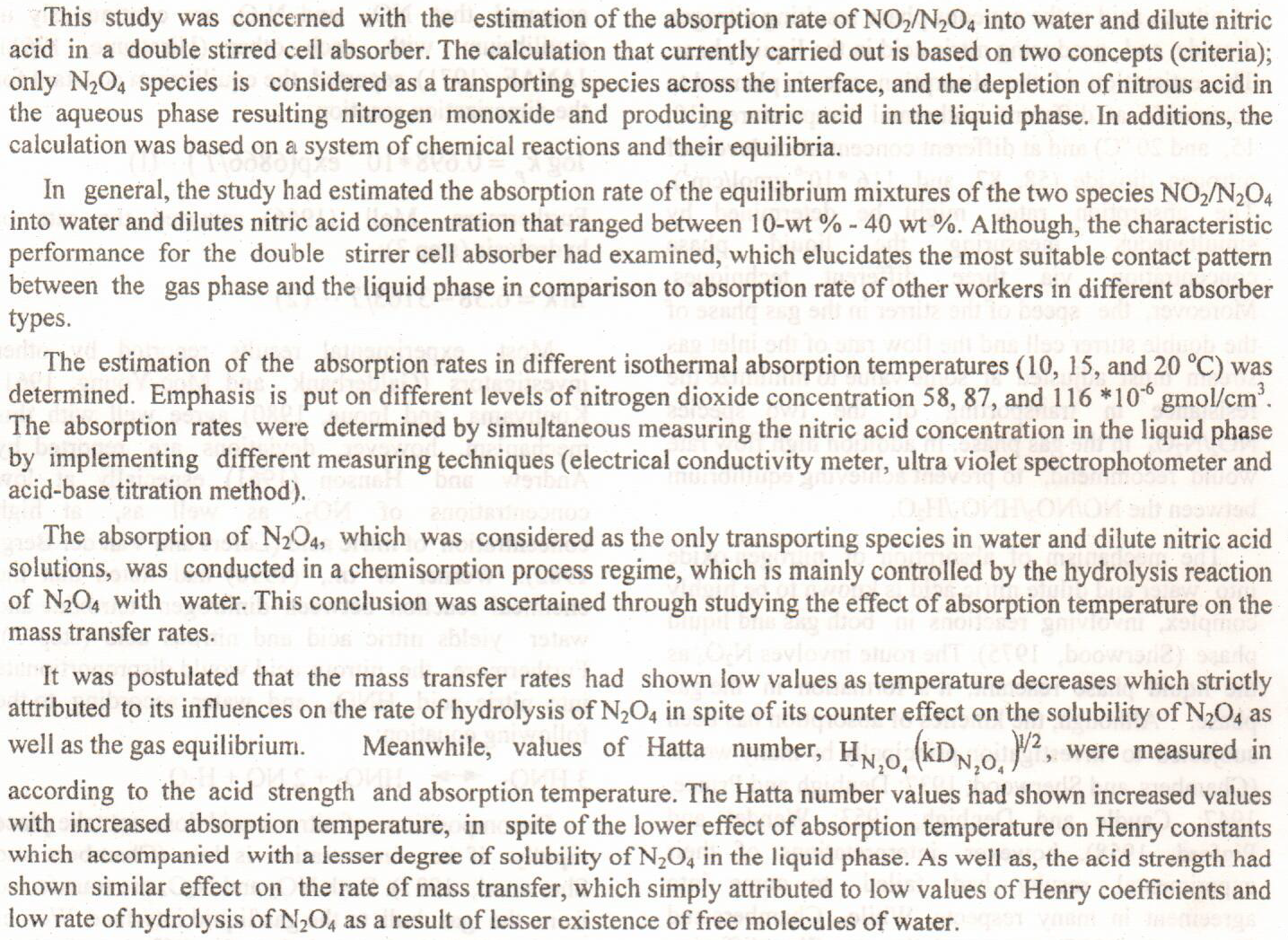
The extraction of Eucalyptus oil from Iraqi Eucalyptus Camadulensis leaves was studded using water distillation methods. The amount of Eucalyptus oil has been determined in a variety of extraction temperature and agitation speed. The effect of water to Eucalyptus leaves (solvent to solid) ratio and particle size of Eucalyptus leaves has been studied in order to evaluate the amount of Eucalyptus oil. The optimum experimental condition for the Eucalyptus oil extraction was established as follows: 100 C extraction temperature, 200 rpm agitation speed; 0.5 cm leave particle size and 6: 1 ml: g amount of water to eucalyptus leaves Ratio.
In this work, an inventive photovoltaic evaporative cooling (PV/EC) hybrid system was constructed and experimentally investigated. The PV/EC hybrid system has the prosperous advantage of producing electrical energy and cooling the PV panel besides providing cooled-humid air. Two cooling techniques were utilized: backside evaporative cooling (case #1) and combined backside evaporative cooling with a front-side water spray technique (case #2). The water spraying on the front side of the PV panel is intermittent to minimize water and power consumption depending on the PV panel temperature. In addition, two pad thicknesses of 5 cm and 10 cm were investigated at three different water flow rates of 1, 2, and 3 lpm. In Case #1,
... Show More (5)
(5)
The study investigates the water quality of the Orontes River, which is considered one of the important water recourses in Syria, as it is used for drinking, irrigation, swimming and industrial needs. A database of 660 measurements for 13 parameters concentrations used, were taken from 11 monitoring points distributed along the Orontes River for a period of five years from 2015-2019, and to study the correlation between parameters and their impact on water quality, statistical analysis was applied using (SPSS) program. Cluster analysis was applied in order to classify the pollution areas along the river, and two groups were given: (low pollution - high pollution), where the areas were classified according to the sources of pollution to w
... Show More (9)
(9)
 (4)
(4)
Abstract
The aim of this paper is to investigate and discuss the mechanisms of corrosion of epoxy coatings used for potable water tanks. Two distinct types of Jotun epoxy coatings: Tankguard 412 contained polyamine cured epoxy and Penguard HB contained polyamide cured epoxy, were tested and studied using the electrochemical impedance spectroscopic (EIS) method. The porosity of epoxy coatings was determined using EIS method. The obtained results showed that the two epoxy coatings have excellent behavior when applied and tested in potable water of Basrah city. Polyamine is more resistance to water corrosion compared to polyamide curing epoxy and has high impedance values. Microscopic inspection after te
... Show More (3)
(3)
The quality of groundwater in the Al-Hawija area was assessed using a water quality index. Data of nine physico-chemical parameters of 28 groundwater wells were used to calculate the water quality index (WQI). A heterogeneous water quality was reported, where in close proximity to the Lesser Zab River (LZR), it has low WQI values and permissible for human consumptions due to the dilution processes by fresh water; whereas, it becomes deteriorated in areas located far away the river. The values of WQI ranges from 22 to 336, indicating a good to very poor groundwater quality.
 (2)
(2)
Background: Radiotherapy, is therapy using ionizing radiation in order to deliver an optimal dose of either particulate or electromagnetic radiation to a particular area of the body with minimal damage to normal tissues. The source of radiation may be outside the body of the patient (external beam irradiation) or it may be an isotope that has been implanted or instilled into abnormal tissue or a body cavity. Called also radiotherapy. The aim of work studies the relationship between the depth dose and the high photon xray energies (6MeV and 10MeV). Patients and methods: in our work, we studied the dose distribution in water phantom given at different depths (zero-18) cm deep at1cm intervals treated with different field size (5×5-,10×1
... Show More (17)
(17)
 (12)
(12)
Problem of water scarcity is becoming common in many parts of the world. Thus to overcome this problem proper management of water and an efficient irrigation systems are needed. Irrigation with buried vertical ceramic pipe is known as a very effective in management of irrigation water. The two- dimensional transient flow of water from a buried vertical ceramic pipe through homogenous porous media is simulated numerically using the software HYDRUS/2D to predict empirical formulas that describe the predicted results accurately. Different values of pipe lengths and hydraulic conductivity were selected. In addition, different values of initial volumetric soil water content were assumed in this simulation a
... Show More (1)
(1)
Bacterial water pollution is a genuine general wellbeing concern since it causes various maladies. Antimicrobial nanofibers can be integrated by incorporating nanobiocides, for example, silver nanoparticles into nanofibers. Nylon 6 was dissolved in formic acid at a concentration of (25 wt. %) and tough antibacterial (AgNO3/Nylon) nanofibers were produced utilizing electrospinning system. Polymer solution was tested before accomplishing electrospinning process to acquire its surface tension, electric conductivity and viscosity, where every one of those parameters increased relatively with increasing concentration of (AgNO3) additions. SEM and EDX spectra were utilized to focus on the morphology, surface elemental mem
... Show More (3)
(3)
This work is based on the synthesis of Cobalt(II) and Cadmium(II) mixed-ligands compounds obtained from the reaction of N'-(4-methylsulfanyl-benzoyl)-hydrazine carbodithioic acid methyl ester as a ligand and using ethylendiamine (en), 2,2'-bipyridine (bipy) or 1,10-phenanthroline (phen) as a co-ligand. The synthesis of ligand (HL) was based on multi-steps synthetic procedure. The reaction of 4-methylsulfanyl-benzoyl chloride with hydrazine gave 4-methylsulfanyl-benzoic acid hydrazide. This compound was reacted with carbon disulfide and potassium hydroxide in methanol to yield N'-(4-methylsulfanylbenzoyl)-hydrazine potassium thiocarbamate, which upon reaction with methyl iodide resulted in the formation of the ligand. A range of physico-chem
... Show More